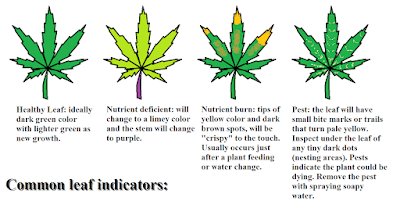Leaf chart for reference
While dealing with hydro systems, you'll notice consistent changes, especially growth, but among the changes you'll see some several indicators for plant stress.
I supplied a small chart to give you some guidance with the most common problems with your plant:
From my experience with growing cannabis for more than a decade, I've noticed that these are my most common problems, and luckily these problems are diagnosed by reviewing the leaf of the plant. Not all of them will be definitive in diagnosing your plant, but many times plants will tell you what's going on with some big indicators:
Healthy leaf: the leaf should be green, dark green, and the sail should be wide, perpendicular to the light source. The bigger they are, the healthier your plant is. Small leaves means they're not getting enough water. Overall your leaf should be dark green and filled with water. You'll find a dew drop or two hanging around the leaf, which indicates your plant's transpiration is in perfect order. Note while during the flowering stage, your green leaves around the flower of the plant will produce trichomes of cannabinoid oils and will give off a "frosty" look. That's a good sign your plant's very healthy during the flowering stage and should be your indication of normality or control. Dark green is healthy.
Nutrient deficiency: the leaf will began to change from dark green to light green, which may reveal "leaf veins" on the face of the leaf and the stem will turn purple. Chances are you put a lot of water into your system and not enough nutrients. This also can cause your leaves to stay small in size. This indicates you need to be feeding your plants by measuring out your food. Note that onset nutrient deficiency can occur during the flowering stage since your plant will take up more nutrients and water than in vegetation stage. Most gardeners will do a heavy dosage of feeding as it builds larger flowers towards the end of the growth cycle. Bright green and purple stems is deficiency.
Nutrient burn: the leaf will begin to change from dark green to yellowing on the tips, or could have dark spots of brown and red on the leaf surface, indicating your plant is taking up too many nutrients at a time. This problem can be easily fixed with a quick water flush, where you replace your water with just water for a day, and then add in nutrients according to how many gallons are in the reservoir. Usually 24 hours stops nutrient burn from spreading after a water flush. Note that this happens usually after a change of water or adding in water and/or plant food during a routine checkup. During these changes, commonly some of the leaves will get burned. Trim the burned ones off after a few days if you see an abundance of healthy leaves, this will tell you your plant's chemistry is balanced. From my experience, I prefer to have the occasional nutrient burn than a nutrient deficiency. Deficiencies can cause long-lasting or permeant damage that drastically hinders the plant's overall system. Regarding nutrient burn, it's usually just a few leaves you need to remove and the remaining system recovers quickly. Yellowing, browning crispy edges, or spots is nute burn.
Pest: the leaf will have small bite marks or trails across the surface of the leaf. By turning your leaf upside down and inspecting the darker areas, you'll usually find dark spots of fecal matter and eggs or webs. That tells you there is a pest present. The most common of pests are thrips and mites. Thrips will be small bugs that leave tiny spots across the entire leaf and when you flick the leaf or shake the plant, the plant will throw a kind of dust in the air, which are the small thrip bugs flying off the plant. If you see small trails, that is a sign of mites. Mites like to dig little trenches across the leaf and make their webbed nests underneath the leaf. All these pests can be removed with manual removal and soapy water. Note, soapy water will not damage your plant. But if you are experiencing pests there's a good chance you have underlying issues with your plant. Pests only arrive if they sense the plant is dying, and they'll use it as a way to build a shelter and lay eggs, so their kin can feed off the dying organic material. Check your plants nutrient levels, tent temperature, water temperature and if you're using soil, check if the soil is draining properly. Pests also can come from other plants, so be sure to keep your garden clean all the time. Yellow spots on the top or black spots on the bottom with a web or two is a pest.
Keep in mind there could be a combination of these indicators and as a gardener, you'll have to determine the diagnosis overall, since every plant is different and nothing is perfect. It takes only one small problem (like no water, power outage, or a bug on your shirt) to ruin a good grow setup. Stay sharp and frosty.
Hope this helps.
-Tumble Inn Hydro Consulting



Comments
Post a Comment